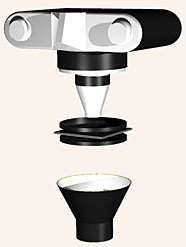Birefringence Photomicrography
I've finally got a place for the scanner, and I've scanned in a few prints.
For those of you who don't know this process, I've provided the simple explanation below.
The crystalline material is grown in a thin film between two pieces of optical glass, in a layer several ten thousandths of an inch thick. Once the crystal has set, the glass plate and crystal assembly is placed between two linear polarizing filters, with the orientation of the filters set to 90° to each other so that they pass a minimum of light.
A light, generally incandescent for the warmer effect it gives on the film, is directed straight up through the assembly.
The camera with some sort of micro lens attached is set up so that it's aimed straight down through the glass/crystal/filter assembly, and the entire assembly is adjusted so that it all lies along the same axis.
Adjustments must then be made so that the crystalline film is in focus, and optimum aperture and exposure settings must be found. At very high magnifications, theoretical resolving power and diffraction through small apertures comes into play, and depth of field can be only a few ten thousandths thick, so stopped down focusing is absolutely necessary.
Setting up and using an assembly like this is quite a bit of work, and can involve a lot of creative fabrication, but the results can be quite impressive.
 Here's a basic rendering of the setup. I may post the complete text of my macro/micro/high magnification instructions at some later date as well.
Here's a basic rendering of the setup. I may post the complete text of my macro/micro/high magnification instructions at some later date as well.
The prints linked to the thumbnails below are completely untweaked scans and they look slightly lackluster because of this. I'll do more and better when I have time.
In the meantime, please enjoy these.
|
Here's a basic rendering of the setup. I may post the complete text of my macro/micro/high magnification instructions at some later date as well.








